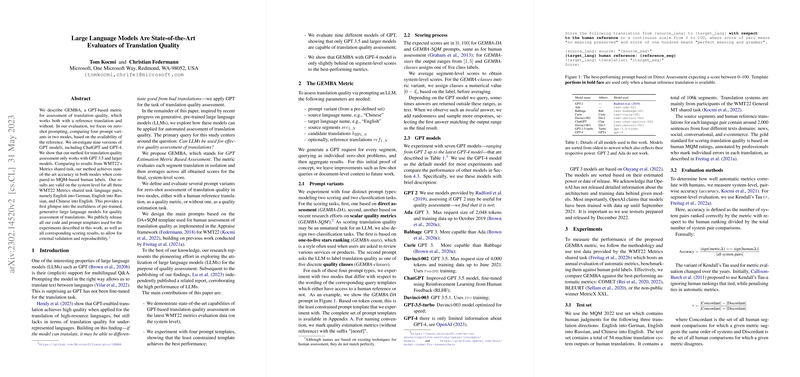Assessment of Translation Quality Using LLMs: An Expert Overview
The paper entitled "LLMs Are State-of-the-Art Evaluators of Translation Quality" by Kocmi and Federmann presents GEMBA, a novel metric for evaluating the quality of translations. GEMBA leverages generative LLMs, specifically focusing on models in the GPT family, to assess the quality of translations both with and without a reference translation. The paper methodically compares multiple variants of GPT models, including GPT-3.5 and GPT-4, and concludes that only models from GPT-3.5 onwards showcase the capability for effective quality assessments.
Core Contributions
- State-of-the-Art Performance: The research highlights that GEMBA achieves state-of-the-art accuracy when evaluated against MQM-based human labels in the WMT22 Metrics shared task. It outperforms existing metrics in different translation directions, specifically English to German, English to Russian, and Chinese to English, at a system level, demonstrating the efficacy of using LLMs for translation quality assessment.
- Prompt Variants and Modes: The paper explores four prompt variants—GEMBA-DA, GEMBA-SQM, GEMBA-stars, and GEMBA-classes—each assessed in scenarios with and without reference translations. Notably, the least constrained prompt template yielded the highest performance, underscoring the importance of prompt design in LLM applications.
- Evaluation Across Different GPT Models: A thorough investigation of various GPT models revealed that while smaller models like GPT-2 and Ada were ineffective, models from GPT-3.5 onwards showed significant potential. The superiority of GPT-4 in this task was particularly notable.
- Public Release for Reproducibility: All code, prompt templates, and corresponding scoring results have been made publicly available, fostering transparency and enabling further research and validation efforts by the AI research community.
Implications and Future Research Directions
The implications of this research are multifaceted. Practically, the ability to automate translation quality assessment has promising applications in machine translation services, potentially reducing reliance on human evaluators. Theoretically, the work provides insights into the capabilities of LLMs, contributing to the broader discourse on their applicability beyond traditional tasks.
This paper paves the way for future enhancements, such as fine-tuning LLMs for translation evaluation tasks and exploring few-shot learning scenarios to potentially augment GEMBA's accuracy. Additionally, expansion into document-level evaluation could address existing gaps, taking advantage of the larger context windows that LLMs support.
Critiques and Considerations
While the paper convincingly demonstrates the power of LLMs in quality assessment, it is important to note the potential constraints related to language diversity. The research's findings are supported by data from high-resource language pairs, and it would be vital to test these methods on low-resource languages, where performance could vary. Also, the deterministic nature of these models when faced with invalid outputs necessitates further investigation into enhancing prompt robustness.
The inability to definitively confirm the exclusion of evaluation data in the model's training set highlights a broader challenge in LLM transparency. This underlines the necessity for rigorous experimental controls and data provenance in LLM research.
In summary, the paper by Kocmi and Federmann significantly advances the understanding and practical application of LLMs in translation quality assessment. By establishing a benchmark for future research in this domain, it invites the AI community to build upon these findings and explore the unresolved challenges revealed by this pioneering work.
